The Mechanism of Resonant Amplification of One-Dimensional Detonation Propagating in a Non-Uniform Mixture
Abstract
1. Introduction
2. Mathematical Model and Statement of the Problem
3. Numerical Algorithm
4. Verification
5. Results and Discussion
5.1. Variation in the Disturbance’s Wavelength
5.2. The Resonant Amplification Case
6. Conclusions
Author Contributions
Funding
Data Availability Statement
Conflicts of Interest
References
- Lee, J.H.S. The Detonation Phenomenon; Cambridge University Press: Cambridge, UK, 2008. [Google Scholar]
- Jiang, Z.; Teng, H. Gaseous Detonation Physics and Its Universal Framework Theory; Springer: Berlin/Heidelberg, Germany, 2022. [Google Scholar]
- Ma, W.J.; Wang, C.; Han, W.H. Effect of concentration inhomogeneity on the pulsating instability of hydrogen–oxygen detonations. Shock Waves 2020, 30, 703–711. [Google Scholar] [CrossRef]
- Kim, M.; Mi, X.; Kiyanda, C.B.; Ng, H.D. Nonlinear dynamics and chaos regularization of one-dimensional pulsating detonations with small sinusoidal density perturbations. Proc. Comb. Inst. 2021, 38, 3701–3708. [Google Scholar] [CrossRef]
- Kasimov, A.R.; Goldin, A.Y. Resonance and mode locking in gaseous detonation propagation in a periodically nonuniform medium. Shock Waves 2021, 31, 841–849. [Google Scholar] [CrossRef]
- Erpenbeck, J.J. Stability of steady-state equilibrium detonations. Phys. Fluids 1962, 5, 604–614. [Google Scholar] [CrossRef]
- Henrick, A.K.; Aslam, T.D.; Powers, J.M. Simulations of pulsating one-dimensional detonations with true fifth order accuracy. J. Comp. Phys. 2006, 213, 311–329. [Google Scholar] [CrossRef]
- Lopato, A.I.; Utkin, P.S. Towards second-order algorithm for the pulsating detonation wave modeling in the shock-attached frame. Comb. Sci Tech. 2016, 188, 1844–1856. [Google Scholar] [CrossRef]
- Poroshyna, Y.E.; Lopato, A.I.; Utkin, P.S. Nonlinear dynamics of pulsating detonation wave with two-stage chemical kinetics in the shock-attached frame. Inverse Ill-Posed Probl. 2021, 29, 557–576. [Google Scholar] [CrossRef]
- Poroshyna, Y.E.; Lopato, A.I.; Utkin, P.S. Characteristic analysis of the dynamics of shock wave propagation in a medium with a nonuniform density distribution. Russ. J. Phys. Chem. B 2022, 16, 670–679. [Google Scholar] [CrossRef]
- Lopato, A.I.; Utkin, P.S.; Poroshyna, Y.E. Numerical study of the mechanisms of propagation of pulsating gaseous detonation in a non-uniform medium. Comp. Res. Modell. 2023, 15, 1263–1282. (In Russian) [Google Scholar] [CrossRef]
- Kasimov, A.R.; Stewart, D.S. On the dynamics of self-sustained one-dimensional detonations: A numerical study in the shock-attached frame. Phys. Fluids 2004, 16, 3566–3578. [Google Scholar] [CrossRef]
- Moulinos, I.; Manopoulos, C.; Tsangaris, S. Computational analysis of active and passive flow control for backward facing step. Computation 2022, 10, 12. [Google Scholar] [CrossRef]
- Sampath, K.; Veerasamy, S.; Agarwal, R.P. Fractional-step method with interpolation for solving a system of first-order 2D hyperbolic delay differential equations. Computation 2023, 11, 57. [Google Scholar] [CrossRef]
- Vasilyeva, M.; Stepanov, S.; Sadovski, A.; Henry, S. Uncoupling techniques for multispecies diffusion-reaction model. Computation 2023, 11, 153. [Google Scholar] [CrossRef]
- Whitham, G.B. On the propagation of shock waves through regions of non-uniform area or flow. J. Fluid Mech. 1958, 4, 337–360. [Google Scholar] [CrossRef]
- Shu, C.-W.; Osher, S. Efficient implementation of essentially non-oscillatory shock-capturing schemes, II. J. Comp. Phys. 1989, 83, 32–78. [Google Scholar] [CrossRef]
- Ng, H.; Higgins, A.; Kiyanda, C.; Radulescu, M.; Lee, J.; Bates, K.; Nikiforakis, N. Nonlinear dynamics and chaos analysis of one-dimensional pulsating detonations. Comb. Theory Modell. 2005, 9, 159–170. [Google Scholar] [CrossRef]
- Leung, C.; Radulescu, M.I.; Sharpe, G.J. Characteristics analysis of the one-dimensional dynamics of chain-branching detonations. Phys. Fluids 2010, 22, 126101. [Google Scholar] [CrossRef]
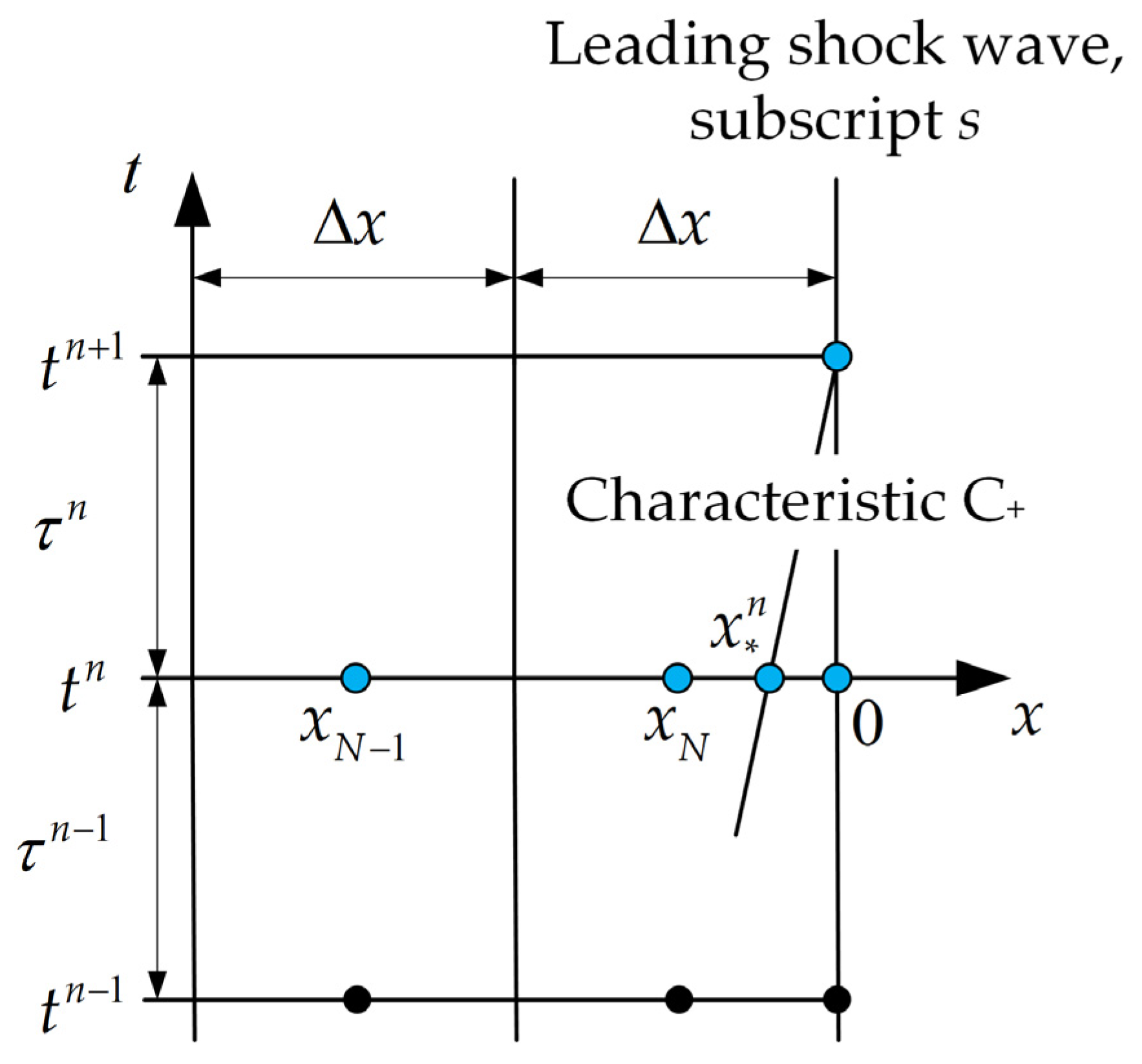
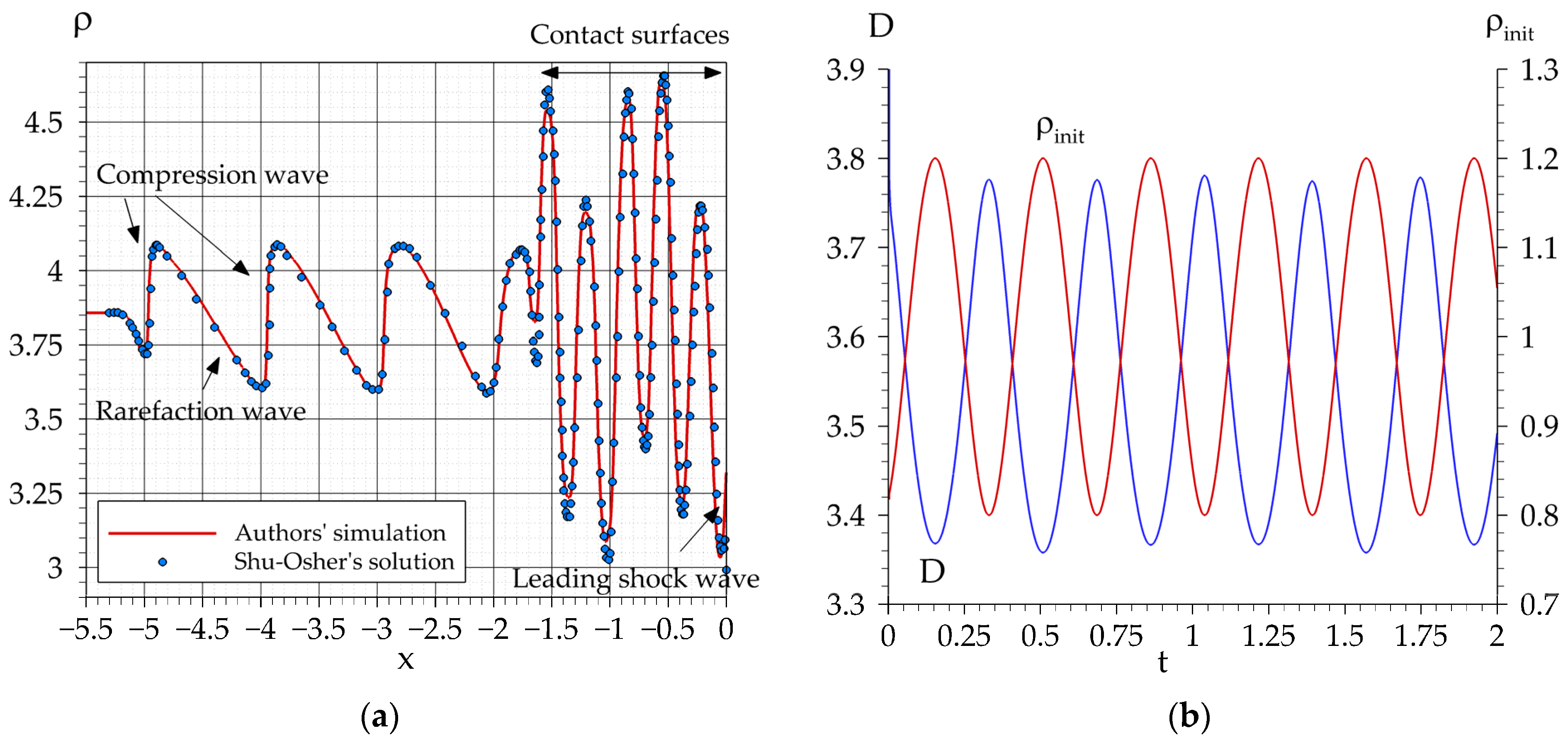
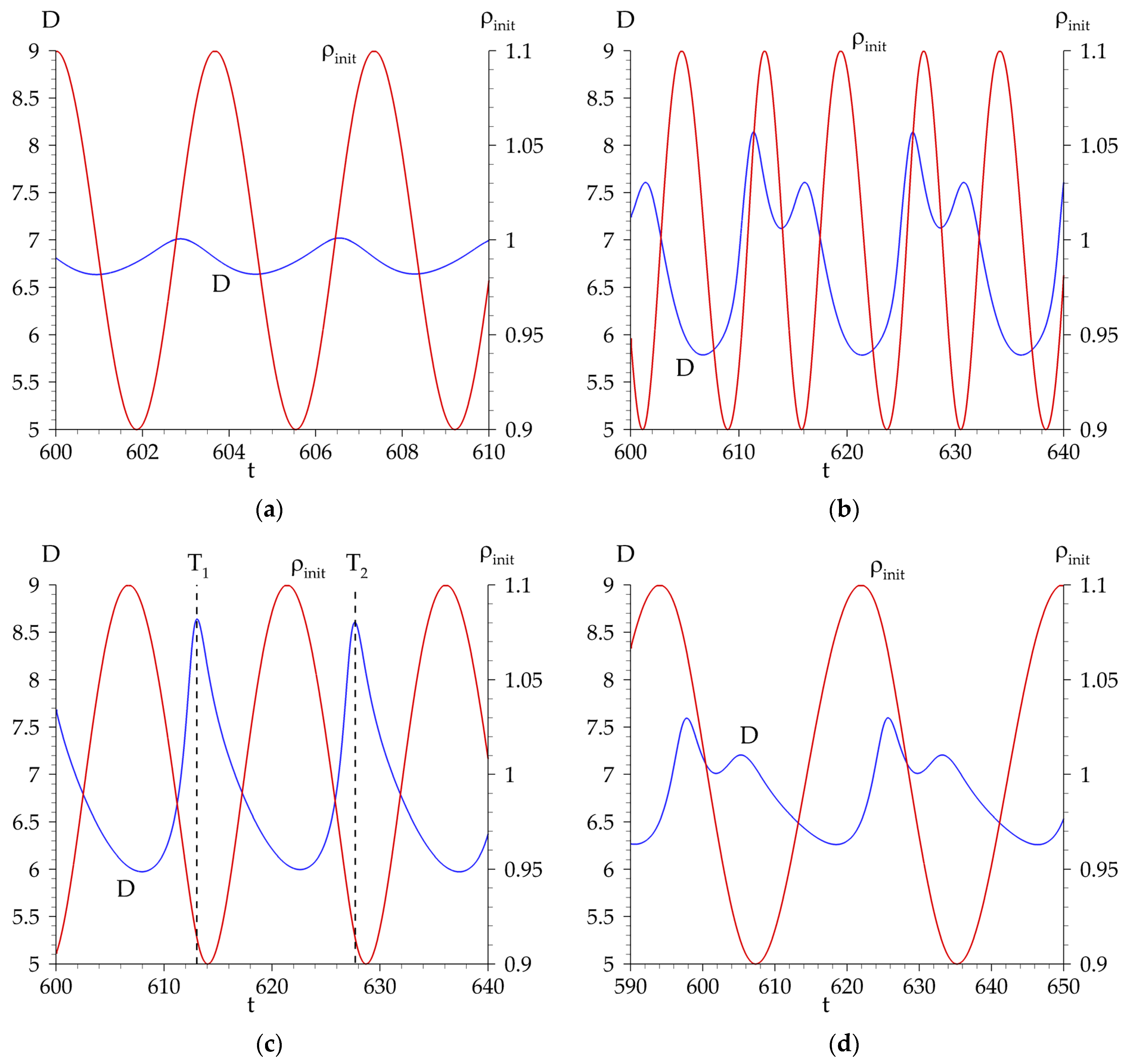
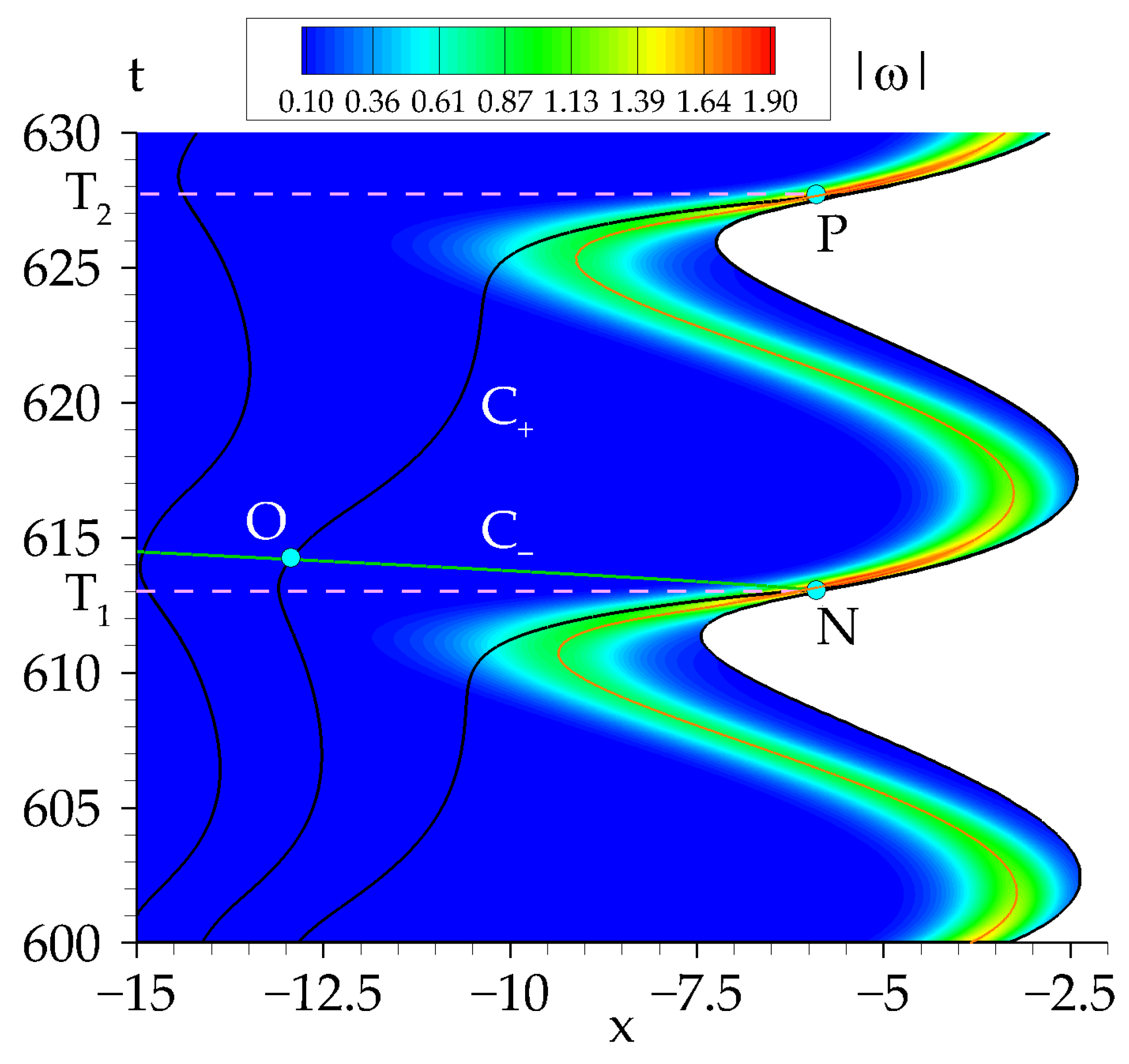
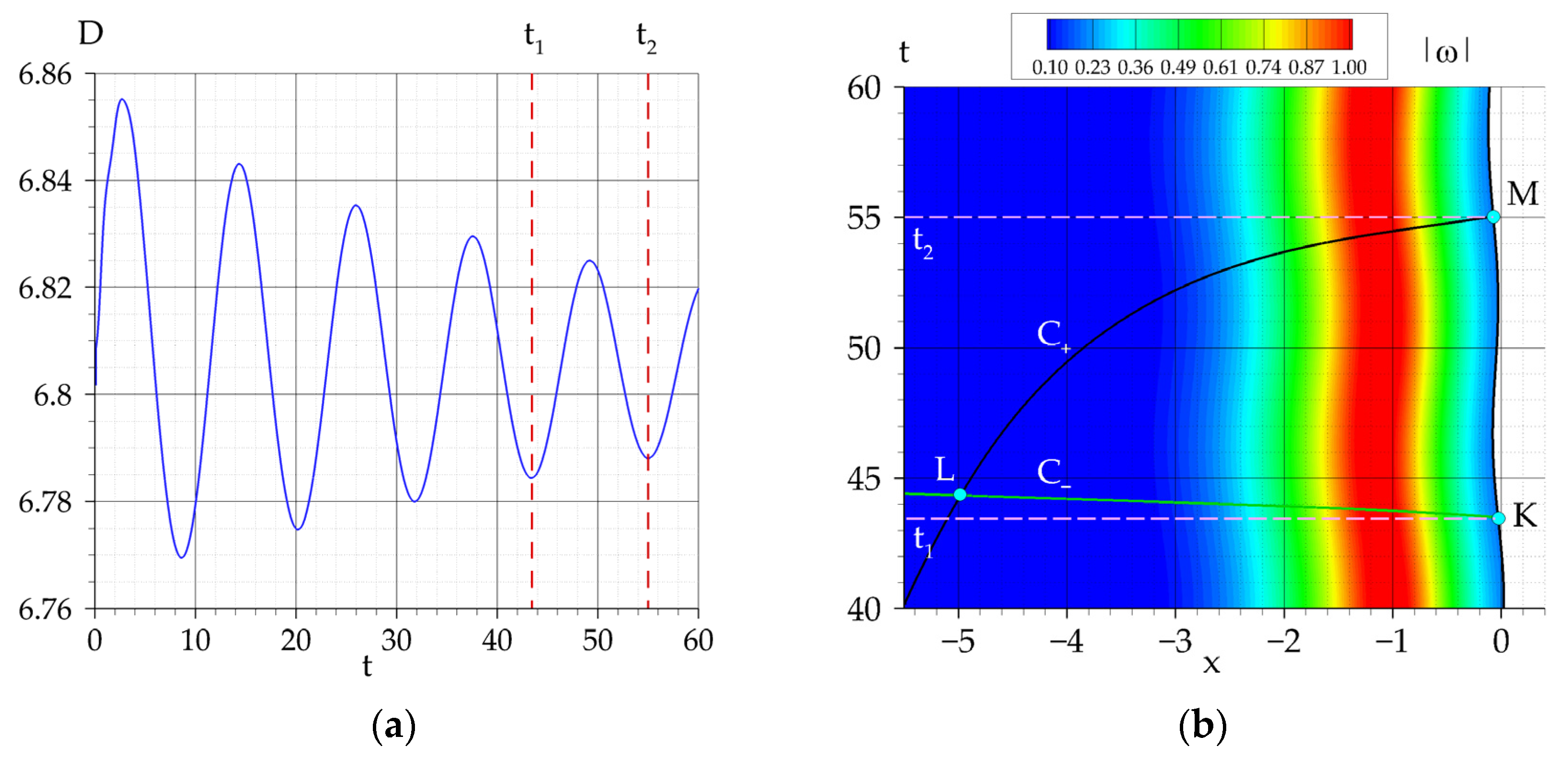
Disclaimer/Publisher’s Note: The statements, opinions and data contained in all publications are solely those of the individual author(s) and contributor(s) and not of MDPI and/or the editor(s). MDPI and/or the editor(s) disclaim responsibility for any injury to people or property resulting from any ideas, methods, instructions or products referred to in the content. |
© 2024 by the authors. Licensee MDPI, Basel, Switzerland. This article is an open access article distributed under the terms and conditions of the Creative Commons Attribution (CC BY) license (https://creativecommons.org/licenses/by/4.0/).
Share and Cite
Lopato, A.; Utkin, P. The Mechanism of Resonant Amplification of One-Dimensional Detonation Propagating in a Non-Uniform Mixture. Computation 2024, 12, 37. https://doi.org/10.3390/computation12020037
Lopato A, Utkin P. The Mechanism of Resonant Amplification of One-Dimensional Detonation Propagating in a Non-Uniform Mixture. Computation. 2024; 12(2):37. https://doi.org/10.3390/computation12020037
Chicago/Turabian StyleLopato, Alexander, and Pavel Utkin. 2024. "The Mechanism of Resonant Amplification of One-Dimensional Detonation Propagating in a Non-Uniform Mixture" Computation 12, no. 2: 37. https://doi.org/10.3390/computation12020037
APA StyleLopato, A., & Utkin, P. (2024). The Mechanism of Resonant Amplification of One-Dimensional Detonation Propagating in a Non-Uniform Mixture. Computation, 12(2), 37. https://doi.org/10.3390/computation12020037





